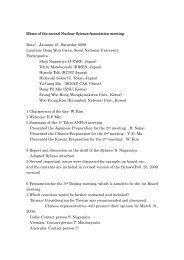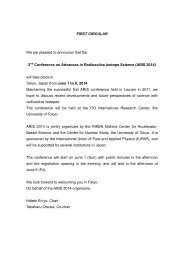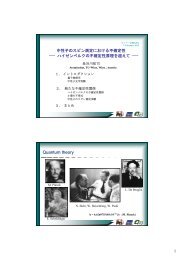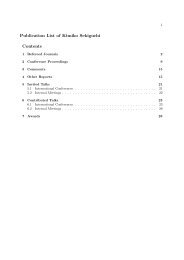An Introduction to the Ion-Optics of Magnet Spectrometers
An Introduction to the Ion-Optics of Magnet Spectrometers
An Introduction to the Ion-Optics of Magnet Spectrometers
You also want an ePaper? Increase the reach of your titles
YUMPU automatically turns print PDFs into web optimized ePapers that Google loves.
Code TRANSPORT:<br />
(x, Θ, y, Φ, 1, dp/p)<br />
(1, 2, 3, 4, 5, 6 )<br />
Convenient “easy <strong>to</strong> use” program<br />
for beam lines with paraxial beams<br />
Not defined in <strong>the</strong> figure are:<br />
dp/p = rel. momentum<br />
l = beam pulse length<br />
Defining a RAY<br />
central ray<br />
<strong>Ion</strong>-optical<br />
element<br />
All parameters are relative<br />
<strong>to</strong> “central ray”<br />
Code: COSY Infinity:<br />
(x, a, y, b, l, δ K , δ m , δ z )<br />
Needed for complex ion-optical systems including several<br />
charge states<br />
different masses<br />
velocities (e.g. Wien Filter)<br />
higher order corrections<br />
Not defined in <strong>the</strong> figure are:<br />
δ K = dK/K = rel. energy<br />
δ m = dm/m = rel. energy<br />
δ z = dq/q = rel. charge change<br />
a = p x /p 0<br />
b = p y /p 0<br />
All parameters are relative<br />
<strong>to</strong> “central ray” properties<br />
Note: Notations in <strong>the</strong> Literature is not consistent! Sorry, nei<strong>the</strong>r will I be.








